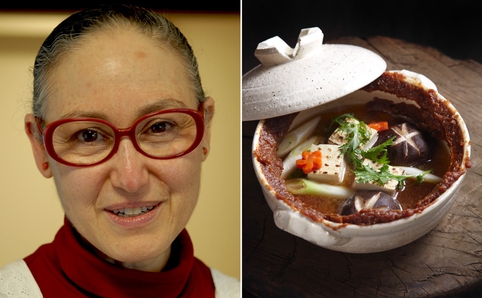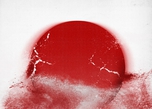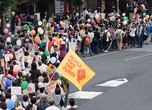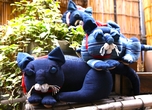Elizabeth Andoh talks ‘Kibō’
The expert food writer brings hope to Tohoku in her new book

Salmon Rice Topped with Red Caviar. Photo by Aya Brackett
Posted: Fri Mar 02 2012
When the quake hit on March 11 last year, Elizabeth Andoh was in the place where you'll so often find her: her kitchen. The culinary doyenne and author of books including Washoku: Recipes from the Japanese Kitchen had a cookery workshop to prepare for the following day – one of many that she conducts each year in her role as the English-speaking world's foremost authority on Japanese cuisine. But as the first rumblings died down, and scenes of destruction began to unfurl on her TV screen, she was already getting the inklings of another, rather more time-consuming project.
‘I knew nothing about the Tohoku,’ she tells Time Out, when we call her to talk about her latest book, Kibō ("Brimming with Hope"): Recipes and Stories from Japan's Tohoku. ‘It was on nobody's radar before all of this happened.’
That’s all changed now, of course. In Kibō, Andoh introduces food and drink from Iwate, Miyagi and Fukushima – the prefectures that were worst affected by the disaster. Regional variations on staples such as onigiri rice balls and miso soup sit alongside more esoteric dishes like sasa kamaboko fish cakes, miso-seared scallops and zunda mochi (rice cakes covered with crushed soybeans). Released this week by Ten Speed Press, Kibō is also only available in e-book format – an unusual move for an author more accustomed to producing lavish hardback tomes, though apparently this was the only way of ensuring that everything would be ready in time for the first anniversary of the disaster.
Though it displays the same meticulous attention to detail that Andoh has shown in her previous books (‘the polite word that [the publishers] used was "information dense",’ she says), Kibō is a comparatively slim tome, stretching to just 17 – admittedly very well presented – recipes. As with previous books Washoku and Kansha: Celebrating Japan's Vegan and Vegetarian Traditions, the author enlisted a team of volunteers to help test and refine the recipes, although she also includes recommendations for locally produced saké from fellow food writer Yukari Sakamoto, plus separately commissioned articles on farmers and restaurateurs who were affected by March 11.
‘It's not the definitive work on the Tohoku, not at all,’ she says. ‘It's, you know, hara hachibu – to whet the appetite – and hopefully people will want more.’

Elizabeth Andoh and one of the recipes from Kibō ("Brimming with Hope"): Recipes and Stories from Japan's Tohoku. Photos by Kristen McQuillin/Aya Brackett
Andoh got her start in anthropology, and perhaps cares more than most about the preservation of culinary traditions. In the introduction to Kibō, she writes about the importance of documenting the region's cuisine 'before traditional foods there morphed into unrecognizable fare, or disappeared entirely’. ‘Most of my Japanese colleagues – it's not that they didn't think it was important, they just felt that there were other things that were more important,’ she says now. ‘And nobody was really going to go do anything about chronicling and bringing [Tohoku cuisine] to a larger audience… Several of my Japanese colleagues said, “How can you write a whole book on Tohoku food?” ’ Point proved.
There’s a charitable side to all of this too, of course: half of the proceeds from the book will be donated to quake relief, although Andoh has opted not to give the money to a major charity. Instead, she’ll be entrusting it to a recovery project overseen by fundraising website GlobalGiving, in which 200 young entrepreneurs are sponsored in their efforts to rebuild the Tohoku region. ‘That's doable, and that has impact,’ she says. ‘And the older I get, the more I realise that it's about impact.’
Having volunteered in Kobe for years after the devastating 1995 Hanshin earthquake, Andoh says she learned the importance of taking a long-term view of the recovery process. ‘It became very obvious to me that the real problems start in the second and third year,’ she says, ‘when the rest of the world’s attention span has gone: people are getting fed up, and nobody is listening, there are new crises. I appreciate – and am very grateful for – those who supported all of the emergency needs [in 2011], but I figured that my drop in the bucket to the American Red Cross was not the way to go with this.’
In true Andoh style, the recipes in Kibō are interspersed with sections that explain in greater detail the techniques and ingredients used. More sobering are the discussions of how the March 11 disaster affected food producers in the region; for instance, the seabeds on the Sanriku coast of Miyagi and Iwate were utterly destroyed, obliterating the local wakame, oyster and scallop industries in the process. There have since been attempts to grow wakame elsewhere but, as Andoh says, ‘terroir food is very specific. There will be thing that cannot be regenerated. Exactly what they are, I'm not sure.’

Still, she’s generally positive about the prospects for recovery in the future. ‘There are going to be new technologies,’ she says, mentioning the possibility of using hydroponics to grow vegetables in otherwise contaminated areas. ‘I just have enormous confidence in Japan in moving forward. The next generation’s very resourceful – and very determined.’ Brimming with hope, indeed.
Kibo ("Brimming with Hope"): Recipes and Stories from Japan's Tohoku by Elizabeth Andoh is out now, published by Ten Speed Press
Tweets
- About Us |
- Work for Time Out |
- Send us info |
- Advertising |
- Mobile edition |
- Terms & Conditions |
- Privacy policy |
- Contact Us
Copyright © 2014 Time Out Tokyo














Add your comment